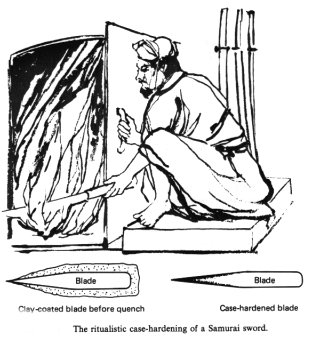The Samurai Sword
Today, let's talk about ceremony and technology. The University of Houston's College of Engineering presents this series about the machines that make our civilization run, and the people whose ingenuity created them.
My grandmother used to tell me that if I burned my finger, I should dip it in a cup of tea. People knew that long before doctors knew anything about the healing power of the tannic acid in tea. My grandmother's finely honed intelligence was in no way lessened by the fact that she'd never studied organic chemistry.
The art of Japanese samurai-sword-making is like that. It reached an astonishing level of perfection 1200 years ago. A samurai sword is a wonderfully delicate and complex piece of engineering. The steel of the blade is heated, folded and beaten -- over and over -- until the blade is formed by 32,768 layers, forge-welded to one another. Each layer is a hundred thousandth of an inch thick. All this is done to extremely accurate standards of heat treatment. The result is an obsidian-hard blade with willow-like flexibility.
Those blades represented a perfection of production standards that's yet to be matched by modern quality control. The Japanese craftsmen who made them knew nothing about temperature measurement or the carbon content of steel. So how do you suppose they made such perfection reproducible? The answer's worth thinking about.
Sword-making was swathed in ceremony and ritual. It was consistent because the ceremony was precise and unvaried. The ceremony was beautiful -- in action, dress, and color. Heat-treating temperatures were set by holding the blade to the color of the morning sun. The exact hue was transmitted from master to apprentice down through centuries. Sword-making was a Japanese art form, subsumed into Japanese culture.
That sort of thing isn't unique to the Japanese. It was true of 18th-century violin-making, and it's still true wherever technology survives independent of math and science. Ritual can accomplish a great deal of what you and I do with weights and measures. Our intelligence, after all, runs deeper than mere gage reading. Our great technologies rise out of a full range of experience. They come from creativity that rides on much more than tables of technical data. Good technology is never independent of culture. The best doctor knows organic chemistry, but he doesn't forget his grandmother's folklore. The best metallurgists know about the iron-carbon phase diagram. But they can see it in the light of a bright yellow-orange blade, emerging from the forge.
Years ago, I worked for a seasoned design engineer. One day he looked at piece of equipment and said, "Look at that heavy gear running on that skinny shaft. Some designer didn't use his eyes." The best engineers know math, physics, and thermodynamics. But they also know the world they live in. The best engineers bring a visceral and human dimension to the exacting math-driven, science-based business of shaping the world around us.
I'm John Lienhard, at the University of Houston, where we're interested in the way inventive minds work.
(Theme music)
The ideas about ceremony and technology are developed nicely by Bronowski, J., The Ascent of Man. Boston: Little, Brown and Company, 1973, Chapter 4, The Hidden Structure. This is also available on videotape and film.
For more on Japanese swords see, Sato, K., The Japanese Sword (tr. by Joe Earl). Tokyo, Kodansha International Ltd. and Shibundo, 1983.
For more on the heat-treating process that yields hardness and strength in a samurai sword, see: J. H. Lienhard IV and J. H. Lienhard V, A Heat Transfer Textbook. 3rd ed., Cambridge, MA: Phlogiston Press, 2004, Click here for a free copy. Section 5.6
This is a greatly revised version of Episode 57.

From A Heat Transfer Textbook, 1981